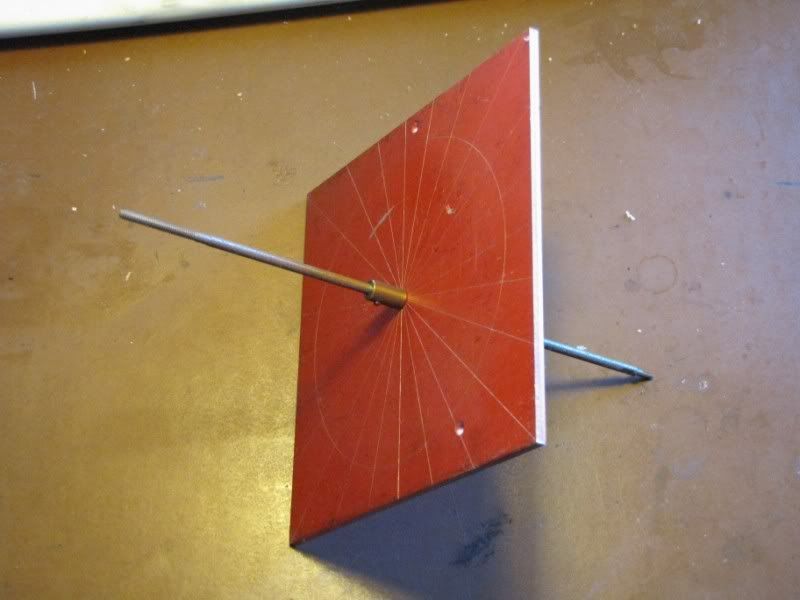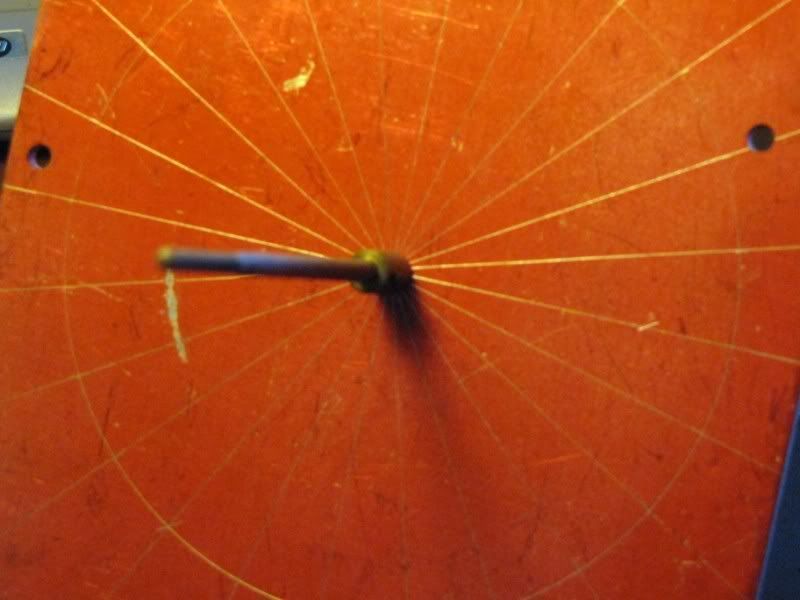mklotz
Well-Known Member
This is a good project for your young budding astronomer (or some old guy who just wants to build a quick toy to play with).
It's an equatorial sundial, arguably the simplest possible design. As the first photo shows, it consists of nothing more than a square metal plate fitted with a central sleeve through which slides a thin metal rod. A setscrew in the sleeve allows the position of the rod to be fixed after adjustment.

Conventional sundials require some faffing about (involving, cover your ears, mathematics) to generate the hour lines. In this design, the hour lines are nothing more than 24 divisions spaced uniformly around the central rod. While one could use an RT or indexer, it's trivial to lay them out using nothing more than a compass and a straightedge. The lines are laid out on both sides of the plate.

Alignment and use...
Place the dial on a flat surface and adjust the sliding rod such that the angle formed between the rod and the flat surface is equal to your latitude. (A friend with a GPS can help you determine accurate values for your latitude and longitude.)
When the sun crosses your meridian (i.e., your local high noon), orient the dial such that the shadow of the rod falls across the vertical hour line (the noon line). The rod will be aligned with the geographical north-south line. You can determine the time of meridian crossing using the SUN program from my site or there are probably web sources for that computation.
That's it. You read the time by noting which hour line the shadow of the rod falls across. Further angular subdivisions are possible, of course. Depending on the season of the year and your location, the shadow may fall on either side of the plate - hence the need for lines on both sides.
Why it works ...
By aligning it as described above, you've made the plate parallel to the earth's equatorial plane and the rod is parallel to the earth's rotation axis. Just as the sun appears to rotate 15 deg/hr about the earth's axis, it will appear to rotate at the same constant rate about the axis of the sundial. This is why we can use equiangular hour lines rather than the complex line geometry seen on conventional horizontal sundials.
It's an equatorial sundial, arguably the simplest possible design. As the first photo shows, it consists of nothing more than a square metal plate fitted with a central sleeve through which slides a thin metal rod. A setscrew in the sleeve allows the position of the rod to be fixed after adjustment.

Conventional sundials require some faffing about (involving, cover your ears, mathematics) to generate the hour lines. In this design, the hour lines are nothing more than 24 divisions spaced uniformly around the central rod. While one could use an RT or indexer, it's trivial to lay them out using nothing more than a compass and a straightedge. The lines are laid out on both sides of the plate.

Alignment and use...
Place the dial on a flat surface and adjust the sliding rod such that the angle formed between the rod and the flat surface is equal to your latitude. (A friend with a GPS can help you determine accurate values for your latitude and longitude.)
When the sun crosses your meridian (i.e., your local high noon), orient the dial such that the shadow of the rod falls across the vertical hour line (the noon line). The rod will be aligned with the geographical north-south line. You can determine the time of meridian crossing using the SUN program from my site or there are probably web sources for that computation.
That's it. You read the time by noting which hour line the shadow of the rod falls across. Further angular subdivisions are possible, of course. Depending on the season of the year and your location, the shadow may fall on either side of the plate - hence the need for lines on both sides.
Why it works ...
By aligning it as described above, you've made the plate parallel to the earth's equatorial plane and the rod is parallel to the earth's rotation axis. Just as the sun appears to rotate 15 deg/hr about the earth's axis, it will appear to rotate at the same constant rate about the axis of the sundial. This is why we can use equiangular hour lines rather than the complex line geometry seen on conventional horizontal sundials.




